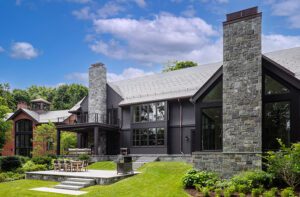Lunaform’s Garden Containers
April 17, 2019
Text by Maria LaPiana
When Phid Lawless and his wife, Sharon, built a home on a large tract of land in Sullivan, Maine, in 1980, it was surrounded mostly by trees and bare granite ledge. The Japanese-inspired house looked out over a quarry, which was striking, but there was no grass, nowhere to plant anything, and no way to add color to the landscape.
The couple decided they needed some urn-like planters, quite large ones, ideally unadorned, to complement the style of their home. What they had in mind was nowhere to be found. So, the resourceful homeowner decided to make them himself.
Eventually, Lawless, an architect, graphic designer, painter, sculptor, and home contractor, partnered with Dan Farrenkopf, a like-minded friend with a background in architecture, painting, and ceramics, to perfect the unique concrete manufacturing process he’d developed—and that’s how Lunaform came to be.
Planters soon led to fountains, fire bowls, benches, prayer wheels, birdbaths, amphoras, and custom concrete work, all with “simple lines and a clean look, like those found in ancient Greek and Roman gardens,” says Lawless. The highly practical, four-season pieces add architectural interest to a wide array of landscapes, private gardens, and the grounds of commercial buildings. The lightest piece weighs forty pounds, while the largest (so far) is a 2,200-pound, ten-foot-diameter basin made for a meditation/healing garden. Some 80 percent of Lunaform’s orders come from landscape architects in the U.S. and Canada.
Lawless and Farrenkopf and the people they employ in their studio make every piece by hand. They named the first vessel they made (and then the company) for a neighbor’s very small, very pregnant cat called Luna. Since then, they’ve named many of their 175-plus designs after places in Italy—Siena, Perugia, Ebro, and Umbria, to name a few.
The proprietary process they developed is complex and labor-intensive, taking a minimum of three weeks from start to finish to complete a piece; on average they produce seven to eight pieces per week, year-round.
While most concrete planters are made using a casting process with inner and outer molds, at Lunaform, every piece is hand-turned on something similar to a clay potter’s wheel—only larger. Though the more common method allows for surface detailing (the outer mold can be made of rubber), it also produces the exterior seam lines that make pieces look mass-produced, which of course they are. “Casting has wonderful properties,” says Lawless. “For example, it’s very fast.” But the method does not allow for the placement of reinforcing steel, which is necessary to provide sufficient tensile strength and the ability to withstand severe weather conditions.
Lunaform’s workers use interior molds only, hand-packing dense, fiber-reinforced, high-strength concrete over them as each piece turns on the wheel. Successive layers are wrapped in galvanized steel and more concrete; then the vessel is rotated through a stationary steel screed to cut off the excess concrete as it goes by. The result is seamless, which makes every piece look handmade, which of course it is. “We had a lot of trial and error in the first year,” says Lawless. “As you can imagine, quite a lot of concrete ended up on our shoes.”
The company’s early success can be attributed to a bit of serendipity. Lawless and Farrenkopf had just completed six or seven Luna urns that were custom-fit at intervals into an iron fence—and the project was featured in Garden Design magazine. “For two weeks, all we did was take calls from landscape architects,” remembers Lawless.
More than a quarter century later, the Rowayton, Connecticut, native couldn’t be happier, doing what he loves in a place he finds altogether enchanting.
How did a guy who went to boarding school in Switzerland and art school in Raleigh, North Carolina, end up making pots in the Maine woods? His older brother had gone to Colby College and later settled in Maine; Lawless visited and fell in love with the area’s beauty and slower pace, so he moved there himself. “I prefer trees to people,” he says with a laugh.
“It’s very attractive to a lot of people, but winters are severe and can prompt a lot of people to move,” he adds. “Occasionally we feel like that, but I honestly can’t imagine where I’d ever go that would be quite like this.”
Lunaform, Sullivan, Maine, 207-422-0923
Share
![NEH-Logo_Black[1] NEH-Logo_Black[1]](https://b2915716.smushcdn.com/2915716/wp-content/uploads/2022/08/NEH-Logo_Black1-300x162.jpg?lossy=1&strip=1&webp=1)















You must be logged in to post a comment.